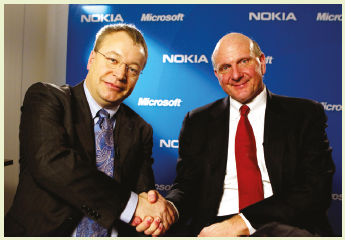1. How could you use the design lens, the experience lens and the variety lens to account...
Question:
2. How could you use the design lens and the experience lens to explain Stephen Elop€™s adoption of the Microsoft operating system?
3. Comment on Stephen Elop€™s changing language from a discourse lens perspective.
Nokia started out in 1865 as a Finnish paper pulp mill. The company only began to take its modern form in 1966 when it had merged with the Finnish Rubber Works and the Finnish Cable Company to form a conglomerate with businesses ranging from rubber boots to aluminium parts.
The Finnish Cable Works had established a small electronics department in 1960 in one corner of its main factory. This electronics department in turn spawned several businesses, including a mobile phone unit launched in 1979 through a joint venture with another Finnish company, Salora.
During the 1980s, Nokia became committed to an active diversification strategy, especially internationally. Businesses were acquired in the television and computer industries, and Salora itself was taken over in 1984. By 1987, an internal strategic planning document identified over 30 strategic business units in a Boston Consulting Group portfolio matrix (see Chapter 8 ), with mobile phones labelled one of several €˜star€™ businesses ripe for investment.
But Nokia then hit a very rough patch. Its chairman and CEO committed suicide in 1988, and many of its industrial markets were hit hard by the collapse of the then Soviet Union. There was a period of losses and top management turmoil, from which finally emerged a new CEO, Jorma Ollila. Ollila had only arrived at Nokia in 1985, after an early career in the American investment bank Citibank. Since 1990, he had been head of the mobile phones business, then accounting for only ten per cent of Nokia€™s total sales.
On appointment as CEO, Ollila had promised continuity. In fact, the company rapidly focused on mobile phones. By 1996, mobile phones accounted for 60 per cent of Nokia sales and two years later Nokia became the world€™s largest mobile phone company. Other businesses were divested, so that soon the only other substantial business was Nokia telecommunications networks and infrastructure business, merged into a joint venture with Siemens in 2007.
Nokia€™s phone business flourished for more than a decade, until two cataclysmic events: first, Apple€™s launch of the iPhone in 2007 and then the 2009 launch of Google€™s Android operating system supported by companies such as HTC and Samsung. At the same time,

Chinese manufacturers began to attack Nokia€™s position in low-cost phones, especially in developing markets. In 2010, Nokia responded to the growing pressure by appointing its first non-Finnish CEO, the Canadian Stephen Elop.
Elop€™s previous company had been Microsoft, another company struggling in the phone market, though he himself had been responsible for Microsoft€™s Office products business. The new CEO launched a wide-ranging strategic review: €˜The very first day I began, I sent out an email to all of the employees and I asked them: what do you think I need to change? What do you think I need not or should not change? What are you afraid I€™m going to miss?€™ A key issue that he and his management team struggled with during the first year was whether Nokia should continue with its own operating system. Operating systems are highly expensive to develop and sustain and need to be attractive to external software developers in order to secure a competitive range of apps. Within a few months, Elop and his team had decided to abandon Nokia€™s own operating system. There were two alternative operating systems available: Google€™s or Microsoft€™s. Elop inclined towards Microsoft. His reasoning was that Microsoft was the weaker of the two, and therefore needed Nokia more than Google did. Nokia also feared being just another Android phone manufacturer competing on the same basis as HTC or Samsung.
PortfolioA portfolio is a grouping of financial assets such as stocks, bonds, commodities, currencies and cash equivalents, as well as their fund counterparts, including mutual, exchange-traded and closed funds. A portfolio can also consist of non-publicly...
Step by Step Answer:

Exploring Strategy Text and Cases
ISBN: 978-1292145129
11th Edition
Authors: Gerry Johnson, Richard Whittington, Patrick RegnÈr, Kevan Scholes, Duncan Angwin





